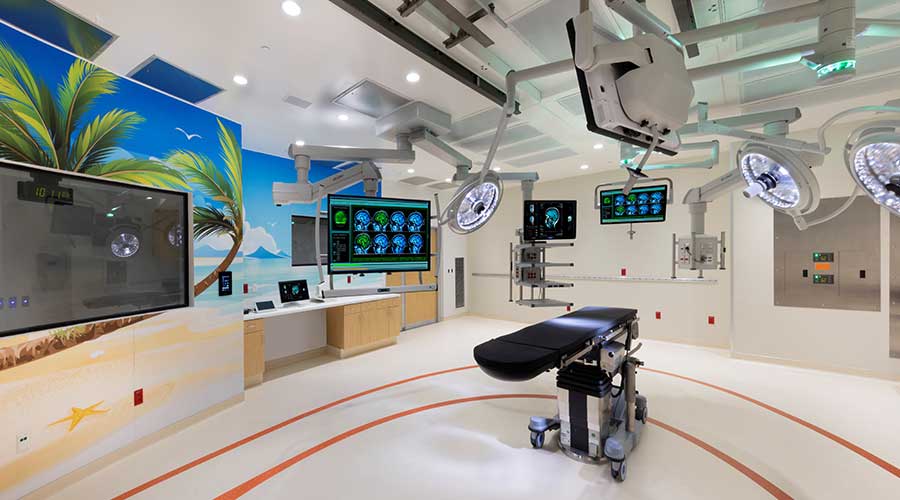As the national crisis in mental health and violence is debated in Washington, there is strong consensus that new inpatient behavioral health facilities are needed across the country. Americans were repelled by the warehousing of patients in large prison like facilities of the 1960s and 70s and massive closures resulted. Now we are equally concerned about the rise in homelessness, substance abuse and violence.
We look to a new model of care that looks to healing and integrating people within their communities. As with acute health care, the future of behavioral health is a system where people are evaluated, treated and returned to society with the support system that they need. As architects we must create environments that support the work of clinical professionals. The question is – what does this new architecture look like?
How can a new model of building design reinforce patient privacy, dignity and respect? What can architecture do to reduce anxiety and agitation? What improvements can we, as architects, suggest for the future of behavioral health buildings? These are important questions to be answered while looking for solutions to our current mental health crisis.
First impressions matter. People arrive at treatment facilities with trepidation and fear. They are particularly frightened by the loss of control of turning themselves over to professional care. It is important that the arrival and first impression is not one that reinforces fear. The building needs a welcoming entrance. Interior spaces should never remind of us prisons. While safety and security are of the utmost importance the environment should reinforce a sense of calm control. Create a place of treatment and healing as opposed to a place of confinement.
Plan for private rooms. Acute care hospitals have moved to all private rooms and behavioral health inpatient units should follow the example. Many of the same reasons for singles apply such as the difficulty in finding appropriate roommates, the need for privacy, and the desire to supply a therapeutic environment free from stress.
Provide opportunities for choice and individual control. Much of the environment is both controlled and restrictive for both safety and therapeutic concerns. Providing opportunities for personal control allows patients to feel some dignity and normalcy. Examples include operable windows, dietary choices, a range of social spaces to choose from and the opportunity to get outside.
Include details that reinforce “normalcy” The creation of rooms and furnishings that mimic residential life contribute to the therapeutic environment: dining tables in a dining room, a kitchen as a social space, residential lighting levels and living areas apart from the corridor and bedrooms. The goal is to return patients to their communities so these home-like details are important to that process.
Safety is a constant concern in every aspect of design. The importance of visibility between staff and patients and anti-ligature architectural details are primary safety concerns but there is more that can be done to promote safety for patients and staff including resilient interior finishes, security systems, cameras, limiting exposure of non-clinical staff and places to move people to if they are overly agitated. Safety is important for staff, patients and visitors.
Allow for both indoor and outdoor opportunities for exercise. Promote healthy bodies as well as minds. Give patients ways to work off excess energy and to participate in constructive activities such as yoga, and basketball. Opportunities for fresh air and exercise promotes normalcy and some relief from the clinical environment.
A strong connection to nature provides a sense of renewal. Contact with the sky, landscape and changing seasons gives hope and pleasure to patients. The environment is perceived as something greater than the building itself and it grounds the experience of the patient. Daylight and views can provide a sense of place and assist with wayfinding. Staff also benefit from connections to nature in their workspace for relieving stress and staying connected to the external world.
Welcoming to visitors. Visiting friends and family are a source of strength for patients. They provide the link between inside and outside worlds. They reinforce family ties and remind patients that they are not alone. But visitors can feel unwelcome if the appropriate accommodation isn’t provided. Designing multiple spaces where safe interaction can occur between patients and visitors supports the value of the outside visit.
Recognize that the practice pattern of caregivers is one of teamwork. The staff caring for the behavioral health patient is typically a diverse group of professionals that work together as a team to create a personalized treatment plan. Psychiatrists, nurses, psychologists, social workers, care advisors, rehabilitation specialists, researchers and educators all work together to inform patient care. Strong communication is essential. The plan for the inpatient unit should include conference spaces both for meeting with the patient and families and for team communication. Designing to enhance collaboration both on and off the unit benefits the clinical work.
As psychiatry grapples with how to best care for patients, behavioral health architecture should be supportive, flexible and deliberately purposeful of the aims outlined above. Security and safety are important but they need to be in balance with the therapeutic goals. Staff deserve appropriate and humane work environment. Patients require a safe and healing environment. Architecture can respond by creating a therapeutic environment filled with light and home-like details. A variety of social spaces and recreational opportunities give patients choices. Private rooms and bathrooms provide dignity and respect. Working with clinical staff to improve the patient experience and outcomes is necessary to prevent the mistakes of the past building typology and to build towards a much improved facility model.
Milly Baker is a senior associate at Payette.

 Authorities Issue Joint Advisory on RansomHub Ransomware
Authorities Issue Joint Advisory on RansomHub Ransomware 9 Steps to a Successful Healthcare Capital Project
9 Steps to a Successful Healthcare Capital Project Steward Health Care to Sell Wadley Regional Medical Center in Texarkana
Steward Health Care to Sell Wadley Regional Medical Center in Texarkana Texas HHSC Breaks Ground on New Terrell State Hospital
Texas HHSC Breaks Ground on New Terrell State Hospital Enhancing Behavioral Healthcare with Thoughtful Design
Enhancing Behavioral Healthcare with Thoughtful Design